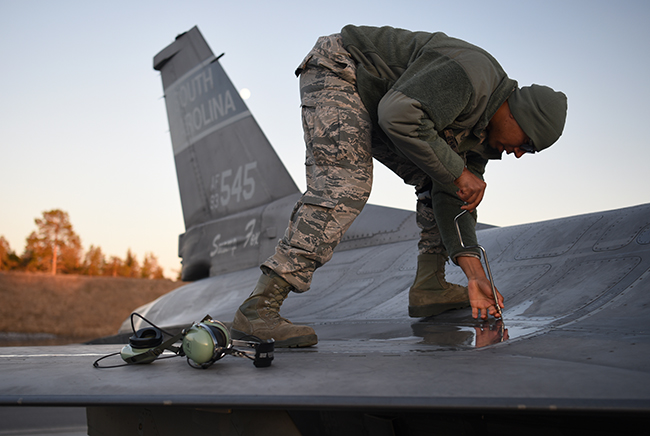
USAF TSgt. Brad Steward, an F-16C Block 52 Fighting Falcon maintainer assigned to the Air National Guard’s 169th Fighter Wing from McEntire Joint National Guard Base, S.C., secures an aircraft panel after the arrival of an F-16 at Kallax AB, Luleå, Sweden, on May 16, 2019 in preparation for Arctic Challenge Exercise 2019. Air National Guard photo by SMSgt. Edward Snyder.
DAYTON, Ohio—Despite the Air Force’s enthusiasm in rolling out data-driven, proactive aircraft maintenance initiatives over the past few years, a top official says someone needs to champion those efforts and shoulder the cost if they are to continue.
“We need to build a better story, the roadmap for how we go forward,” Air Force Materiel Command boss Gen. Arnold Bunch said in a June 20 interview here. “We need to find a way to measure the true value of what we’re getting out of these.”
The service has two main predictive maintenance programs: one called “Conditions-Based Maintenance Plus” that uses sensors to gather data on when parts may break, and another artificial intelligence-driven effort in partnership with Silicon Valley’s Defense Innovation Unit and the AI developer C3. Together, the pilot programs cover or plan to include the B-1, C-5, C-135 variants, C-130, E-3, F-16, and F-35.
Last July, the Air Force launched a Rapid Sustainment Office as a two-year test to see what return on investment it could garner from forward-looking sustainment practices like predictive analytics. That office oversees CBM+, which is proving its worth by warning maintainers when faulty sensors need to be replaced and foreshadowing failures that would cost hundreds of thousands of dollars to fix. In one example reported by Inside Defense last year, C3’s AI application created an algorithm that shrank unscheduled maintenance for the E-3 Airborne Warning and Control System by about one-third using around seven years of upkeep data.
But the push to bake analytics into each program and expand them to other platforms hasn’t gotten as much traction as some might like.
“There’s great promise there for what we can do, but there’s an investment we need to make on the front end to be able to reap those rewards,” Bunch said of CBM+ in a keynote address at an Air Force Life Cycle Management Center conference. “We’ve got to tell that story and get the Air Force to buy in.”
Bunch told reporters that senior leaders recently discussed the issue and agreed predictive maintenance is critical to boosting aircraft availability rates and managing aging fleets. The service holds regular meetings on rapid sustainment that Bunch, previously the Air Force’s top uniformed acquisition official, recently attended for the first time in his new role as AFMC commander.
To move forward, the Air Force must combine its new sustainment ideas into a comprehensive, service-wide strategy instead of pursuing each smaller pilot separately.
“I need to digitize some of the data and the historical data to be able to use in some of the databases,” Bunch said. “I may need to buy certain algorithms to be able to manipulate everything. There are certain costs associated with it that we will need to do to be able to make it work, and that’s just part of the cost of doing business.”
DIU estimates the Pentagon could save $15 billion each year if C3’s AI algorithm spreads to all Defense Department aircraft, according to C4ISRNET. The Air Force is still hashing out a bigger picture of how much money it could save through predictive maintenance.